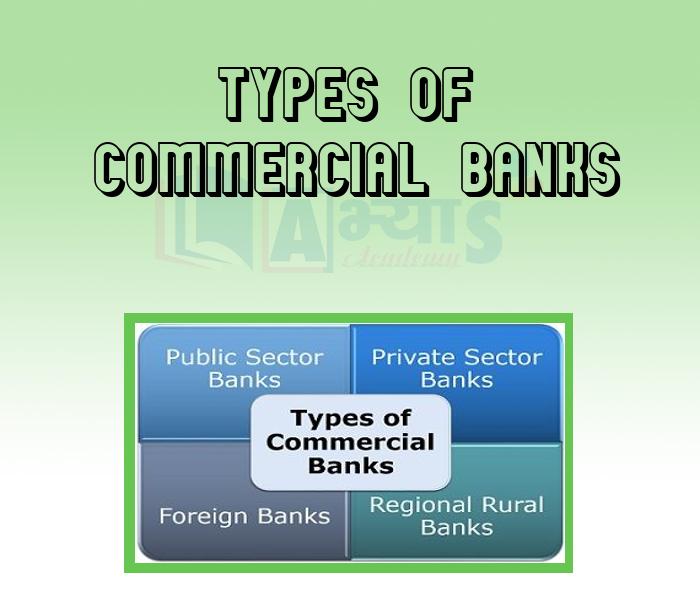Types Of Commercial Banks










Types Of Commercial Banks
Commercial banks are of three types i.e.. Public sector banks, Private sector banks and Foreign banks.
Public Sector Banks:
These are banks where majority stake is held by the Government of India or Reserve Bank of India. Examples of public sector banks are: State Bank of India, Corporation Bank, Bank of Baroda and Dena Bank, etc.
Private Sectors Banks:
In case of private sector banks majority of share capital of the bank is held by private individuals. These banks are registered as companies with limited liability. For example: The Jammu and Kashmir Bank Ltd., Bank of Rajasthan Ltd, Development Credit Bank Ltd, Lord Krishna Bank Ltd., Bharat Overseas Bank Lid.. Global Trust Bank. Vysya Bank, etc.
Foreign Banks:
These banks are registered and have their headquarters in a foreign country but operate their branches in our country. Some of the foreign banks operating in our country are Hong Kong and Shanghai Banking Corporation (HSBC). Citibank, American Express Bank. Standard & Chartered Bank. Grindlay's Bank, etc. The number of foreign banks operating in our country has increased since the financial sector reforms of 1991. According to a report by RBI there are 45 foreign banks branches in India as on January 31.2018.
Development Banks
Business often requires medium and long - term capital for purchase of machinery and equipment, for using latest technology, or for expansion and modernization. Such financial assistance is provided by Development Banks. They also undertake other development measures like subscribing to the shares and debentures issued by companies, in case of under subscription of the issue by the public. Industrial Finance Corporation of India (IFCI) and State Finance Corporations (SFCs) are examples of development banks in India.
Co - operative Banks :
People who come together to jointly serve their Common interest often form a co-operative society under the Co - operative Societies Act. When a co-operative society engages itself in banking business it is called a Co-operative Bank. The society has to obtain a license from the Reserve Bank of India before starting banking business. Any co-operative bank - as a society has to function under the overall supervision of the Registrar. Co-operative Societies of the State. As regards banking business, the society must follow the guidelines issued by the Reserve Bank of India.
Bank having maximum number of branches in India is __________________ | |||
| Right Option : B | |||
| View Explanation | |||
Students / Parents Reviews [10]
It was good as the experience because as we had come here we had been improved in a such envirnment created here.Extra is taught which is beneficial for future.

Eshan Arora
8thAbhyas Methodology is very good. It is based on according to student and each child manages accordingly to its properly. Methodology has improved the abilities of students to shine them in future.

Manish Kumar
10thIt was a good experience with Abhyas Academy. I even faced problems in starting but slowly and steadily overcomed. Especially reasoning classes helped me a lot.

Cheshta
10thAbhyas is a complete education Institute. Here extreme care is taken by teacher with the help of regular exam. Extra classes also conducted by the institute, if the student is weak.

Om Umang
10thOne of the best institutes to develope a child interest in studies.Provides SST and English knowledge also unlike other institutes. Teachers are co operative and friendly online tests andPPT develope practical knowledge also.

Aman Kumar Shrivastava
10thMy experience with Abhyas is very good. I have learnt many things here like vedic maths and reasoning also. Teachers here first take our doubts and then there are assignments to verify our weak points.

Shivam Rana
7thBeing a parent, I saw my daughter improvement in her studies by seeing a good result in all day to day compititive exam TMO, NSO, IEO etc and as well as studies. I have got a fruitful result from my daughter.

Prisha Gupta
8thAbout Abhyas metholodology the teachers are very nice and hardworking toward students.The Centre Head Mrs Anu Sethi is also a brilliant teacher.Abhyas has taught me how to overcome problems and has always taken my doubts and suppoeted me.

Shreya Shrivastava
8thMy experience with Abhyas academy is very good. I did not think that my every subject coming here will be so strong. The main thing is that the online tests had made me learn here more things.

Hiya Gupta
8thA marvelous experience with Abhyas. I am glad to share that my ward has achieved more than enough at the Ambala ABHYAS centre. Years have passed on and more and more he has gained. May the centre flourish and develop day by day by the grace of God.
